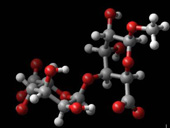Modelling carbohydrates
Carbohydrates, the most naturally abundant biomolecule, function in a number of roles, from maintaining structural integrity to providing energy-storage. However, it is the centrality of carbohydrates in biomolecular recognition, mediating events such as cell-cell interaction and the immune response that offers major opportunities for therapeutic intervention. These polar flexible molecules expose many of the shortcomings of current computational modeling methods.
We use a range of methods to study the energetics and dynamics of carbohydrates in the condensed phase. In particular, we have explored the use of combined QM/MM potentials and molecular dynamics. To enable the calculation of free energy surfaces, in collaboration we have derived a focused semi-empirical QM Hamiltonian to specifically improve modelling of carbohydrates.
Selected publications
- Tryptophan as a molecular shovel in the glycosyl transfer activity of Trypanosoma cruzi trans-sialidase. F. L. Mitchell, S. M. Miles, J. Neres, E. V. Bichenkova and R. A. Bryce. Biophys. J. 2010, 98, L38-L40.
- An evaluation of the GLYCAM06 and MM3 force fields, and the PM3-D* molecular orbital method for modelling prototype carbohydrate-aromatic interactions. A. Ramraj, R. K. Raju, Q. Wang, I. H. Hillier, R. A. Bryce, M. A. Vincent. J. Mol. Graph. Model. 2010, 29, 321-325.

